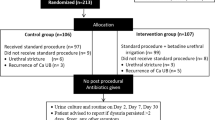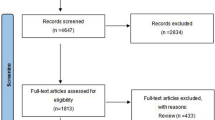Abstract
Pediatric neuropathic bladder dysfunction can cause irreversible renal damage and urinary incontinence. Etiologically, it is usually the consequence of a congenital neural tube defect. The majority of affected children can be successfully managed with the standard medical treatment of clean intermittent catheterization and anticholinergic (typically oxybutynin) medication. A subset of patients experience severe side effects or insufficient suppression of detrusor overactivity on oral oxybutynin. Intravesical instillations offer an effective alternative; this Review considers their indications, administration, safety and efficacy.
Key Points
-
Topical therapy for pediatric neuropathic bladder has been suggested as an alternative to the standard treatment of oral anticholinergics and intermittent catheterization
-
A subset of children who fail to respond adequately to oral anticholinergics might be candidates for intravesical therapy
-
Initial reports of intravesical oxybutynin claim greater urodynamic efficacy and reduced side effects
-
Use of intravesical oxybutynin has proved effective in a small number of studies, but claims regarding superiority over oral administration are hampered by the low level of evidence
This is a preview of subscription content, access via your institution
Access options
Subscribe to this journal
Receive 12 print issues and online access
$209.00 per year
only $17.42 per issue
Buy this article
- Purchase on Springer Link
- Instant access to full article PDF
Prices may be subject to local taxes which are calculated during checkout
Similar content being viewed by others
References
Reitz, A. & Schurch, B. Intravesical therapy options for neurogenic detrusor overactivity. Spinal Cord 42, 267–272 (2004).
Kurzrock, E. A. & Polse, S. Renal deterioration in myelodysplastic children: urodynamic evaluation and clinical correlates. J. Urol. 159, 1657–1661 (1998).
Verpoorten, C. & Buyse, G. M. The neurogenic bladder: medical treatment. Pediatr. Nephrol. 23, 717–725 (2008).
Smith, E. D. Urinary prognosis in spina bifida. J. Urol. 108, 815–817 (1972).
Dik, P., Klijn, A. J., van Gool, J. D., de Jong-de Vos van Steenwijk, C. C. & de Jong, T. P. Early start to therapy preserves kidney function in spina bifida patients. Eur. Urol. 49, 908–913 (2006).
Chapple, C. R., Yamanishi, T. & Chess-Williams, R. Muscarinic receptor subtypes and management of the overactive bladder. Urology 60, 82–88 (2002).
Yamamoto, H., Kawano, P. R., Balasteghin, K. T., Padovani, C. R. & Amaro, J. L. Protective action of intravesical oxybutynin on bladder ultrastructure in rabbits with detrusor overactivity. Int. Urogynecol. J. 20, 229–234 (2009).
Scheepe, J. R. et al. The effect of oxybutynin on structural changes of the obstructed guinea pig bladder. J. Urol. 178, 1807–1812 (2007).
Amend, B. et al. Effective treatment of neurogenic detrusor dysfunction by combined high-dosed antimuscarinics without increased side-effects. Eur. Urol. 53, 1021–1028 (2008).
Donnellan, C. A., Fook, L., McDonald, P. & Playfer, J. R. Oxybutynin and cognitive dysfunction. BMJ 315, 1363–1364 (1997).
Brendler, C. B., Radebaugh, L. C. & Mohler, J. L. Topical oxybutynin chloride for relaxation of dysfunctional bladders. J. Urol. 141, 1350–1352 (1989).
Buyse, G. et al. Intravesical oxybutynin for neurogenic bladder dysfunction: less systemic side effects due to reduced first pass metabolism. J. Urol. 160, 892–896 (1998).
Hayashi, A. et al. Treatment with modified intravesical oxybutynin chloride for neurogenic bladder in children. J. Pediatr. Urol. 3, 438–442 (2007).
Guerra, L. A. et al. Intravesical oxybutynin for children with poorly compliant neurogenic bladder: a systematic review. J. Urol. 180, 1091–1097 (2008).
Ferrara, P., D'Aleo, C. M., Tarquini, E., Salvatore, S. & Salvaggio, E. Side-effects of oral or intravesical oxybutynin chloride in children with spina bifida. BJU Int. 87, 674–678 (2001).
Franco, I. et al. Efficacy and safety of oxybutynin in children with detrusor hyperreflexia secondary to neurogenic bladder dysfunction. J. Urol. 173, 221–225 (2005).
Wan, J. & Rickman, C. The durability of intravesical oxybutynin solutions over time. J. Urol. 178, 1768–1770 (2007).
Sellers, D. J. & McKay, N. Developments in the pharmacotherapy of the overactive bladder. Curr. Opin. Urol. 17, 223–230 (2007).
Ehren, I. et al. Efficacy and impact of botulinum toxin A on quality of life in patients with neurogenic detrusor overactivity: a randomised, placebo-controlled, double-blind study. Scand. J. Urol. Nephrol. 41, 335–340 (2007).
Neel, K. F., Salem, M. & Soliman, S. Total endoscopic management (TEM approach) of children with non-compliant neuropathic bladder: a preliminary report. J. Pediatr. Urol. 4, 124–126 (2008).
Fader, M. et al. Intravesical atropine compared to oral oxybutynin for neurogenic detrusor overactivity: a double-blind, randomized crossover trial. J. Urol. 177, 208–213 (2007).
Lazzeri, M., Spinelli, M., Zanollo, A. & Turini, D. Intravesical vanilloids and neurogenic incontinence: ten years experience. Urol. Int. 72, 145–149 (2004).
Author information
Authors and Affiliations
Corresponding author
Ethics declarations
Competing interests
The author declares no competing financial interests.
Rights and permissions
About this article
Cite this article
Lazarus, J. Intravesical oxybutynin in the pediatric neurogenic bladder. Nat Rev Urol 6, 671–674 (2009). https://doi.org/10.1038/nrurol.2009.214
Published:
Issue Date:
DOI: https://doi.org/10.1038/nrurol.2009.214
This article is cited by
-
The urological evaluation and management of neurogenic bladder in children and adolescents—what every pediatric nephrologist needs to know
Pediatric Nephrology (2024)
-
The Management of the Pediatric Neurogenic Bladder
Current Bladder Dysfunction Reports (2016)



